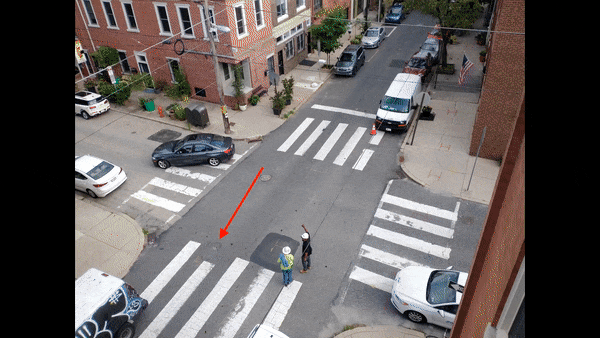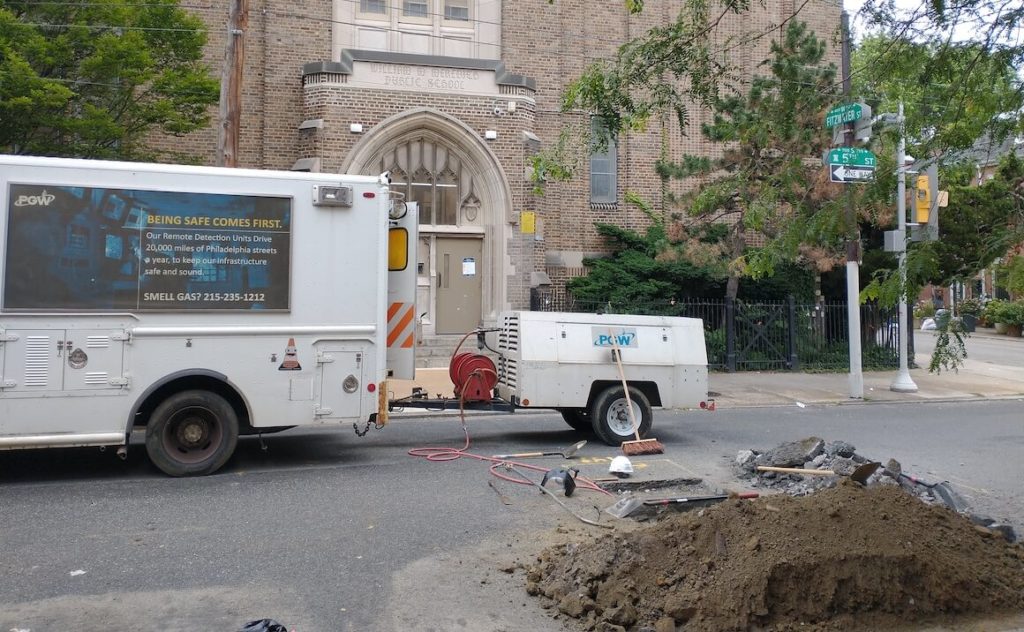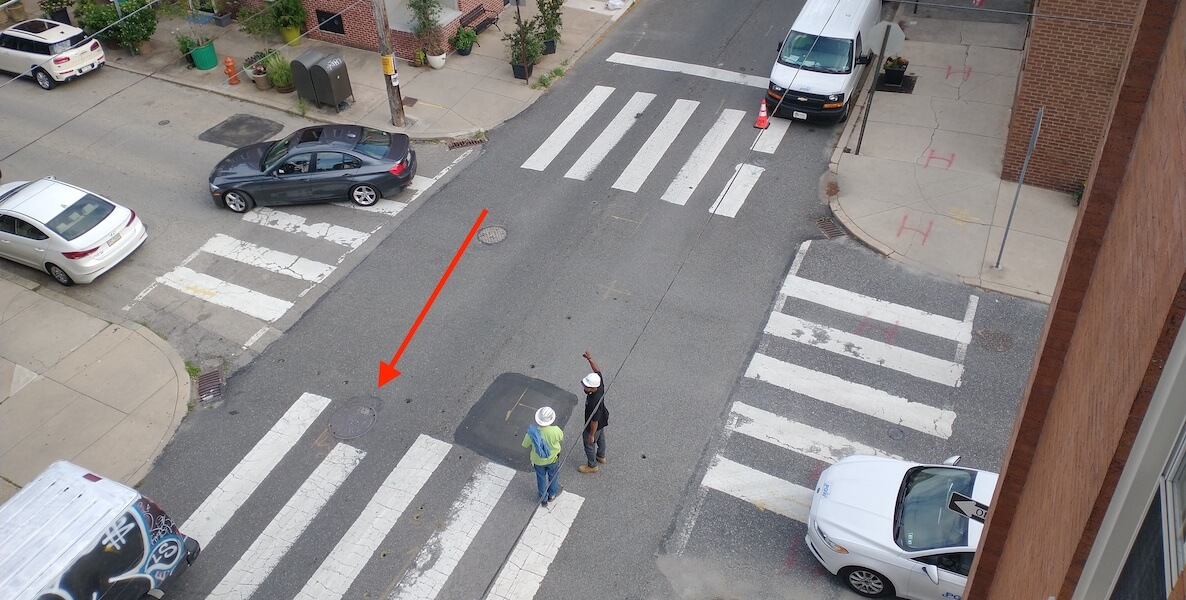On a warm September night, Philadelphia Gas Works (PGW) was having trouble finding a potentially dangerous gas leak next to an elementary school on my block. I’d seen the billowing plume of methane clearly through the lens of my employer-issued optical gas imaging (OGI) camera, but PGW’s emergency crew didn’t have have access to any such equipment. They were relying on me after searching the street themselves and coming up empty.
“Did you check that Verizon manhole cover over there?” I asked, pointing to an intersection less than 50 feet from Meredith Elementary School. A gas main located at the cross streets had been leaking for over six months. The site supervisor walked over and took a measurement from the manhole cover. His gas meter went from green to yellow to red.
“We missed this one,” he said.

Before I knew it, my street was filled with the sounds of beeping equipment and jackhammering, as a PGW emergency crew worked through the night to patch up the leak. The sounds were all too familiar. I’d been hearing them on and off for over six months, as PGW’s emergency workers repeatedly responded to a leaky gas main on my street.
Living in the right place at the right time
It’s pure coincidence that someone should have access to a state-of-the-art OGI camera while living next to an ongoing gas leak in Philadelphia. In my work as a Field Advocate with Earthworks, I use this camera to hunt down methane pollution from oil and gas wells, compressor stations, and other facilities that move the fossil fuel across Pennsylvania. When I started in my role in March, I never imagined the possibility of using an OGI camera on my own block. I pictured rural counties hours away from Philadelphia, where fracking’s boom has too long been wreaking havoc. It turns out that oil and gas production and transportation facilities are not the only places where dangerous methane leaks into the open air.
The FLIR GF320 optical gas imaging camera is designed specifically to locate methane gas that is emitted into the atmosphere, making visible this otherwise invisible pollution. It’s the industry and regulatory standard for leak detection and repair. In April, I was trained and certified as an optical gas imaging thermographer, alongside oil and gas industry workers, but it wasn’t until June that I started looking at my own street with the camera.
I never imagined the possibility of using an OGI camera on my own block. I pictured rural counties hours away from Philadelphia, where fracking’s boom has too long been wreaking havoc. It turns out that oil and gas production and transportation facilities are not the only places where dangerous methane leaks into the open air.
At the time, I was getting ready for a trip to look at older and abandoned wells in Pennsylvania’s Allegheny National Forest. As I packed up my supplies for the six hour drive ahead, I saw PGW vans outside my window; by then, the sight was not unusual. The vans (and loud jackhammering) had been present on my block over a dozen times since February. But a new thought occured to me at that moment: perhaps some of the equipment I was packing for my trip could help me learn more about what was going on here in Philadelphia, on my own block.
A tormenting cycle of repairs
PGW had responded to a gas leak at my intersection the prior evening, and had been jackhammering the pavement between my apartment and the elementary school for most of the day. I wondered if this was the same leak they’d responded to at this intersection dozens of times at all hours of the night in February, March, April, and May. Why hadn’t the previous repairs stopped the gas main from leaking? Was the leak truly repaired when the workers left? If so, why did the leaking and emergency repairs keep happening? Were these new leaks?
When the PGW emergency crew completed their repairs and left that evening, I went outside with the OGI camera in hand. What I saw through the lens shocked me. A giant plume of gas was billowing out of a manhole cover in the middle of the intersection. The gas leak was massive, despite PGW finishing their work and leaving the scene. I called the PGW emergency hotline and was told a crew would show up immediately to take a look at the problem. When the (new) emergency crew arrived and detected an unsafe level of gas coming from the manhole cover, the jackhammering began again.

The problem was that PGW’s best attempts at repair didn’t solve the problem.
Like clockwork, a tormenting cycle repeated itself. A crew would arrive and work extensively to repair the leak, only for me to document large plumes of gas billowing from Verizon manhole covers after nearly every attempt at repair. Between February and September 2021, I watched PGW emergency crews return to my block to address leaking gas dozens of times. On several occasions, PGW site supervisors needed my assistance to help them find the leak. After a neighbor told me she smelled gas at the other end of our block in late June, I pointed my camera at the manhole cover at that intersection and saw a large plume of methane rising from it—even bigger than what I had seen at the original intersection. The gas leak at my end of the block had momentarily subsided, but it appeared to have found a new outlet.
A recent Drexel study concluded that gas leakage in the city is about four times what the U.S. Environmental Protection Agency estimates.
The last repair on my block happened in September, shortly after I helped PGW find the location of the latest leak. For the time being, this fix seems to have held up. I have not documented any methane gas leaking in the intervening months. But the block between Meredith Elementary School and my apartment building is now covered in a patchwork of scars from one end to the other, a telltale sign of the numerous emergency repairs performed by PGW over the past year.
After multiple emails from Queen Village Neighbors Association and City Councilman Mark Squilla this summer and fall, PGW finally agreed to add the gas main on my block to their schedule for replacement over the next several months. This was a small, but hard-won victory. Yet, replacing one gas main does not represent a solution to the larger problem of methane gas leaking across the city (and in many other major American cities) and across the fossil fuel industry as a whole.
Not every block should need an optical gas imaging thermographer
We don’t need a thermographer on every block to know Philadelphia has a problem with leaking methane gas. A recent Drexel study concluded that gas leakage in the city is about four times what the U.S. Environmental Protection Agency estimates. PGW aims to replace all of Philadelphia’s cast iron gas mains by 2050, by which point many of them will be over 150 years old.
 At least 50 percent of Philadelphia’s gas mains are made of cast iron, including the one on my block. Cast iron is no longer permitted when new gas mains are installed, because it is known to corrode and crack easily, especially during freeze-thaw cycles. This increases the likelihood of leaks, and some of them result in deadly explosions like one that happened in South Philly two years ago this month.
At least 50 percent of Philadelphia’s gas mains are made of cast iron, including the one on my block. Cast iron is no longer permitted when new gas mains are installed, because it is known to corrode and crack easily, especially during freeze-thaw cycles. This increases the likelihood of leaks, and some of them result in deadly explosions like one that happened in South Philly two years ago this month.
Efforts are now underway by local Sierra Club volunteers to map out the worst methane leaks in PGW’s distribution lines. This work is modeled after a similar effort in Boston, which was recently profiled in the Washington Post. Researchers in Boston found that about 50 percent of methane leaks in the city’s gas distribution infrastructure are coming from just 7 percent of distribution lines. In 2019, one of these researchers testified before Philadelphia City Council, noting that the same scenario may be true in our city. Mapping gas leaks can help ensure that “super-emitters” – those leaks that are releasing the most methane into the atmosphere – are prioritized for gas main replacement.
Solutions at our fingertips
Funding from President Biden’s bi-partisan infrastructure plan should provide some additional resources to make priority replacements possible. However, it would be short-sighted to make an enormous investment in replacing every PGW distribution main and service line in our city, locking Philadelphia into decades more reliance on methane gas.
In addition to the danger of explosion, methane leaks represent a significant threat to our climate. This summer’s Intergovernmental Panel on Climate Change report made clear that methane pollution, which is 86 times worse for the climate than carbon dioxide, is driving at least 25 percent of the human-caused warming of our atmosphere. The same report suggests that oil and gas methane—the very same gas leaking out of the manhole covers on my block—should be the focus of targeted reductions. This is why we must not be fooled by false solutions or by disingenuous legislative attempts to limit Philadelphia from moving beyond fossil fuels.
Without the ability to see the pollution right in front of us, it is easy to ignore the ticking time bomb beneath our feet. But it shouldn’t take another deadly explosion for our city to commit to acting on the solutions already at our fingertips.
Our city is already actively planning for PGW’s diversification in order to achieve carbon neutrality by 2050, an objective that cannot be met if Philadelphia depends on methane gas for energy. The idea suggested by advocates in Boston is to triage the worst leaks – the super-emitters—and then move as quickly as possible to a safer, renewable energy source. Groups like Geodelphia and POWER Interfaith suggest that geothermal energy, which is moving forward in Boston, could be a key part of a just transition to renewables in Philadelphia. These advocates recommend that PGW run a pilot project on networked geothermal energy in the city.
Whether Philadelphia moves forward with geothermal energy or another alternative to methane, our city will see benefits to not only climate, but public safety. From extraction and production in the gas lands of Pennsylvania to the streets of Philadelphia, I’ve seen methane gas polluting and causing significant harm across our entire state. As long as we continue relying on a flammable greenhouse gas for energy, more explosions will occur and our climate crisis will worsen.
While I never imagined using an OGI camera to watch invisible methane leaking on my own block, the experience has been eye-opening. Without the ability to see the pollution right in front of us, it is easy to ignore the ticking time bomb beneath our feet. But it shouldn’t take another deadly explosion for our city to commit to acting on the solutions already at our fingertips. With the advocacy of concerned Philadelphians, including the family members of those whose lives have been tragically lost, we can hold PGW accountable for the safety of our communities today and for generations to come.
Melissa Ostroff is the Pennsylvania Field Advocate at Earthworks, where she uses optical gas imaging to respond to community concerns, inform policy, and ensure public health and environmental protection are prioritized across the state.
The Citizen is one of 20 news organizations producing Broke in Philly, a collaborative reporting project on solutions to poverty and the city’s push towards economic mobility. Follow the project on Twitter @BrokeInPhilly.
The Citizen welcomes guest commentary from community members who stipulate to the best of their ability that it is fact-based and non-defamatory.
Gas leak at 5th and Fitzwater | Photo by Melissa Ostroff



